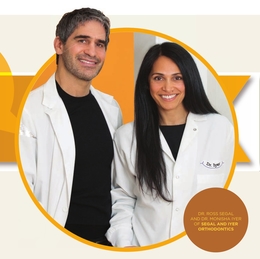
Technology is dramatically changing the way orthodontics is delivered. Orthodontists who leverage the new technologies are able to treat with greater precision and achieve outstanding results in less time than ever before. Two of Suburban Family’s Top Orthodontists, Dr. Monisha Iyer and Dr. Ross Segal, answer our readers’ questions about how these new technologies are being used, and what it means for you.
I read something online about orthodontists using cone beams, but the orthodontist I spoke with doesn’t use them. Are they important?
What you read was probably about Cone Beam Computed Tomography (CBCT) systems, which are capable of taking 3-D X-rays. Yes, they are an impor tant resource because the two-dimensional nature of traditional dental X-rays does not tell the whole story. For example, 2-D X-rays provi de limited information about the position of an impacted tooth—if they reveal it at all—and how surrounding teeth might be affected. CBCT equipment allows orthodontists to see teeth, tissue and bone in three dimensions. Consequently, they can better assess whether treatment is needed, what treatment is required and when it should begin.
Analyzing the bone structure surrounding the roots of the teeth is an im portant part of treatment planning. When traditional X-rays can’t supply the data we need, we use CBCT technology to provide a clearer pic ture. This enables us to align not only the teeth but the roots as well, so we’re able to achieve superior cosmetic results.
Although the benefits of CBCT systems are compelling, they are not yet widely used by orthodontists. The equipment can cost upwards of $100,000, whic h deters some practices from investing in the technology.
We were advised that our son needs braces, but it kind of felt like we were bei ng pressured to do something he doesn’t need. How can we be sure?
It’s sometimes difficult to be sure, but here are some things you can do that should reduce your uncertainty: • If you have questions about the process—or why orthodontic treatment is recommended—be sure to as k all of them. Your orthodontist should be able to explain the process and benefits in terms you understand so you can make the decision that’s right for you, and your child.
• If you’re not satisfied with their answers, don’t hesitate to get a second opinion. Many offices offer free consultations. The vast majority of orthodontists will give you their honest opinion, but those opinions may vary depending on t he doctors’ knowledge, experience and resources.
• Even if you don’t feel qualified to second-guess an orthodontist’s recommendation, yo u can learn from the experiences of others. See what other patients and their families have to say. You’ll find online reviews for most pr actices and some of the comments will likely address issues that are important to you.
• Some orthodontists use technology that will allo w you to see how your child’s smile will look after treatment—before treatment even begins. This might help you decide whether to procee d with treatment.
• In the end it comes down to trust. If you’re uncomfortable with the orthodontist you are considering, look for anothe r practice.
Does treatment still usually take two years or more?
Although average treatment times have declined over the past decade, it’s still not unusual for cases to last two years or more. Treatment times depend on a variety of fa ctors including the current position of the teeth, characteristics of surrounding bone, type of orthodontic treatment being applied and—in the case of Invisalign—whether the patients wear their aligners regularly. Some practices employ advanced acceleration technologies and me thods, so they’re able to give patients the option to significantly reduce their treatment times. Here are the ones we’ve found to be mo st effective:
AcceleDent reduces treatment times by up to 30 percent through the use of precisely calibrated vibrations that stimulate bo ne remodeling. Patients wear the AcceleDent mouthpiece for 20 minutes a day while performing routine activities (reading, showering, wat ching TV, etc.). It’s a comfortable process. In fact, many patients have reported that it relieves the pain they occasionally experience with braces. Patients may choose to use Accele- Dent whether they’re being treated with braces or Invisalign.
Propel involves a chair-side procedure that’s conducted every 10 to 12 weeks, as needed. The orthodontist uses a Propel Excellerator to stimulate remodeling of th e bone surrounding the teeth, which accelerates their movement. Capable of reducing treatment times by 30 to 50 percent—sometimes even more—it’s the fastest non-surgical acceleration technique on the market today. Using Propel, we routinely complete cases in less than 12 m onths that might otherwise take two years or more. Like AcceleDent, Propel can be used in conjunction with braces or Invisalign.
Insignia is an orthodontic system that features indirect bonding and custom-designed brackets. Orthodontists with the necessary skills and experien ce can use Insignia’s 3-D software to plan and manage treatments that not only produce outstanding results, but are so efficient they’ve b een shown to reduce treatment times by over 30 percent.
In 2016, Invisalign modified its treatment guidelines to allow for more frequent al igner changes; every seven days. By utilizing acceleration technology, orthodontists can increase that frequency to every three to four days. They can achieve the same excellent results, in less time, without compromising quality of care.
If I need braces, is there a way to avoid the molding material they use to take impressions of my teeth? It always makes me gag.
Perhaps one of the most revolutionary chang es in orthodontics has been the use of digital 3-D scanning. With a simple handheld wand, we are able to capture the information needed to create complete models of a patient’s teeth and gums. For patients, this 3-D technology has eliminated the need for those goopy, gag-indu cing impressions. Just as exciting is the ability for us to show patients their virtual results before treatment even begins. Digital sca nning delivers superior precision too, providing a much clearer and more detailed representation of the patient. Orthodontists using thi s technology are able to treat more precisely and minimize length of treatment.
When should I see an orthodontist?
The American Association of Orthodontists recommends that children have orthodontic evaluations by age 7. That’s good advice. There are some situations, such as overcrowding, irregular jaw growth or cross bites that can lead to serious complications if not treated early.
Although every child should be evaluated at age 7, few will require treatment at such a young age. We prefer a conservative approach to orthodontics. In our points of view, too many children receive treatment before their ideal time, and a few receive treatment they ultimately may not have needed. Waiting until a child’s permanent teeth have come in can minimize disruption and treatment times, so when possible that’s what we recommend.
SEGAL AND IYER ORTHODONTICS
501 Route 73 S., Suite 202 | Marlton | (856) 810-1006 | SegalAndIyer.com
Published (and copyrighted) in Suburban Family Magazine, Volume 8, Issue 12 (February 2018).
For more info on Suburban Family Magazine, click here.
For information about advertising in Suburban Family Magazine, click here.
To find out where to pick up your copy of Suburban Family Magazine, click here.




